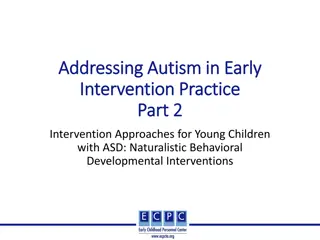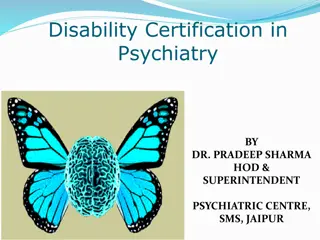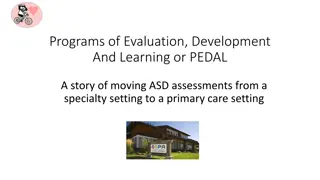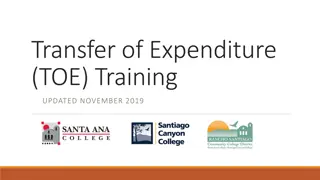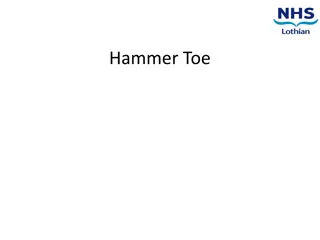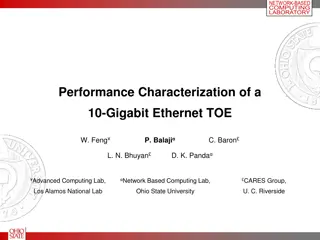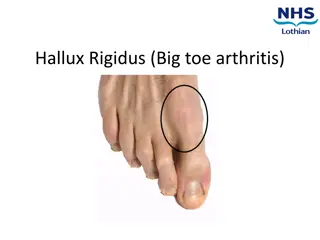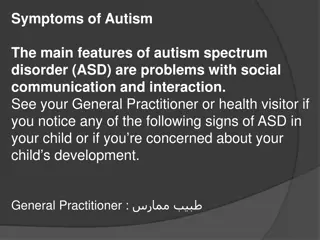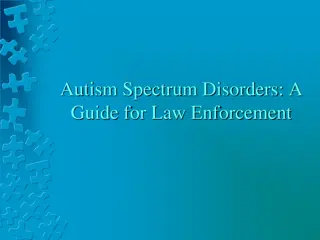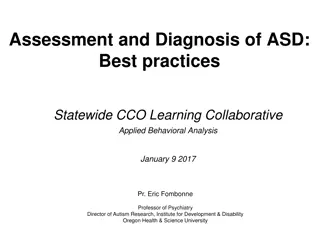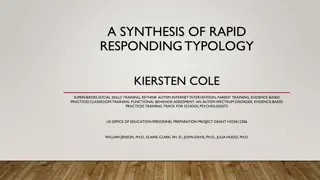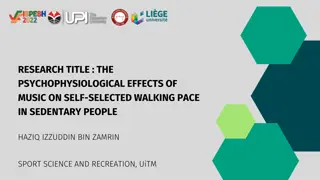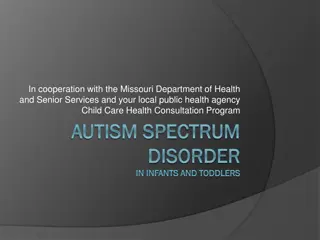Understanding Toe Walking in Children with ASD
This presentation outlines the definition, characteristics, possible causes, and treatment options of toe walking in children with Autism Spectrum Disorder (ASD). The content discusses the incidence of toe walking in children with ASD, common motor deficits associated with ASD, and the potential outcomes of untreated toe walking. It also explores sensory issues, decreased proprioception, hypotonia, and vestibulo-visual problems as potential causes of toe walking in this population.
Download Presentation

Please find below an Image/Link to download the presentation.
The content on the website is provided AS IS for your information and personal use only. It may not be sold, licensed, or shared on other websites without obtaining consent from the author. Download presentation by click this link. If you encounter any issues during the download, it is possible that the publisher has removed the file from their server.
E N D
Presentation Transcript
ASD and Toe Walking Christina Lanzone, SPT UNC Chapel Hill, DPT 2013
Presentation Outline Toe walking definition Incidence in children with ASD Theories on cause of toe walking in children with ASD Possible outcomes of untreated toe walking Treatment options for toe walking Plan of action
What is toe walking The failure of the heel to contact the floor at onset of stance during gait Can be a problem if it persists after 6 months after beginning to walk Can present with a variety of pediatric diagnoses Neuromuscular diagnoses Orthopedic conditions Myopathies Idiopathic Toe Walking
ASD: common motor deficits Hypotonia FM deficits GM deficits History of delayed motor milestones Toe walking Apraxia Impaired balance Impaired equilibrium reactions
Toe Walking and ASD Incidence reported to be between 20-63% Characteristics: Bilateral May be able to walk with heels down briefly when requested May increase when barefooted May increase when excited, tired May or may not have limited DF ROM
Possible Causes of Toe Walking in Children with ASD Sensory issues Decreased proprioception Hypotonia Vestibulo-visual issues
Sensory Issues Tactile hypersentivity Tactile hyposensitivity In sensory integration theory, proprioception is credited with being modulating, calming input
Decreased Proprioception Toe walking increases proprioceptive input Again, can be a modulating, calming input
Hypotonia Can cause ankle instability Toe walking provides increased ankle stability
Vestibulo-Visual Issues Many children with autism have adequate focal vision, but impaired ambient vision Theory that they have either tunnel vision or alternating vision Results in difficulty seeing in three dimensions and correctly detecting the movement and distance of objects toe walk to subconsciously increase their awareness of where they are in space to accommodate for these visual deficits
From their perspective When autistic people walk on their toes, it is because it provides a greater sense of feeling your body and knowing where it is in space and helps balance and feeling like you re not going to tip over and helps relieve some dizziness if any occurs with vestibular problems Kristina DesJardins author of Autism: Life in the Prism creator of the website Autism and its World
Possible Issues of Untreated Toe Walking Increased risk of falls Foot and ankle deformities Triceps surae contractures Decreased function Increased risk of ankle injury Limited DF ROM leads to foot compensations which can cause foot and knee problems Can require surgery
Treatments for toe walking in children with ASD PT OT Therapeutic optometrist Orthotics Serial Casting Surgery
Physical Therapy Evaluation PMH Birth history Medical history Developmental history GM skills Balance concerns Onset of toe walking Family history of toe walking? Review current and past therapy
Physical Therapy Evaluation Systems Review Pain assessment Integumentary assessment Speech and language screen Sensory processing screen Consider referring for screening for language delay and for autism spectrum disorders
Physical Therapy Evaluation Physical Assessment Neurological exam Musculoskeletal exam Gait exam Gross motor skills assessment
Physical Therapy Treatment Can include: Stretching the ankle plantarflexors Strengthening the anterior tibialis and other LE and trunk muscles Parent education and HEP Orthotic intervention Shoe modification Gait training Night splinting Serial casting
Orthotics Inserts Braces Day braces Night braces Shoe modifications
Serial Casting Can be accompanied by Botox injections
Occupational Therapy Treatment Therapeutic brushing Graded desensitization to tactile input Providing other proprioceptive input: Jumping on a trampoline Stomping feet Walking in the sand Providing traction Other activities that provide compression and traction
Therapeutic Optometrist Vision training program developed by Melvin Kaplan, OD Uses ambient prism lenses to actually alter perception in ways that cause patients to reorganize their visual processes Reports immediate short term effects, long term effects can take up to a year
Surgery Lengthening Achilles tendon or gastrocnemius Recession of part or all of the gastrocnemius
Plan of Action! Refer children who have been toe walking for more than 6 months after beginning to walk for physical therapy evaluation! Consider apparent cause of toe walking Work as a team to provide the best care Thank you for your time!
Works Cited Barrow, W. J., Jaworski, M., & Accardo, P. J. (2011). Persistent toe walking in autism. Journal of Child Neurology, 26(5), 619-21. doi: 10.1177/0883073810385344 Collmer, K. (2011, November 7). [Web log message]. Retrieved from http://community.advanceweb.com/blogs/ot_8/archive/2011/11/07/to e-walking-and-vision-unlikely-companions-that-we-need-to-see-to- believe.aspx DesJardins, K. (2010, February 20). [Web log message]. Retrieved from http://chat1autism.wetpaint.com/page/Autism and tip- toeing..why? Edelson, S. M. (2011). Toe walking. Autism Research Institute, Retrieved from http://www.autism.com/index.php/symptoms_toe_walking Gregory, G. (2009, March 01). [Web log message]. Retrieved from http://www.helium.com/items/1360205-autism-and-toe-walking
Works Cited Kaplan, M. (2006). Visual management: a physiological approach to rehabilitating autism spectrum disorders. Autism research review international, 20(2), 3. Retrieved from http://www.autisticvision.com/cvmUpdateInfo/articles/vismgt.PDF Ming, X., Brimacombe, B., & Wagner, G. C. (2007). Prevalence of motor impairment in autism spectrum disorders. Brain Development, 29(9), 565-70. Retrieved from http://www.ncbi.nlm.nih.gov/pubmed/17467940 Le Cras S., Bouck J., Brausch S., Taylor-Haas A.; Cincinatti Children s Hopsital Medical Center: Evidence-based clinical care guideline for Management of Idiopathic Toe Walking. Guideline 040, pages 1-17, February 15,2011 http://www.cincinattichildrens.org/service/j/anderson-center/evidence- based-care/occupational-therapy-physical-therapy/ Yoell, C. (2011, March 06). Toe walking in children with autism. Retrieved from http://ebookbrowse.com/toe-walking-handout-doc-d75647361 Zimbler, S. (2010). Idiopathic toe walking: current evaluation and management. Orthopedic Jounralat Harvard Medical School, Retrieved from http://www.orthojournalhms.org/volume9





